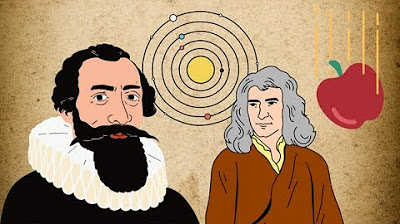Lesson 3 - Lecture 1 - Understanding Orbits - Tycho & Kepler - OpenStax
Summary
TLDRThis video explores the evolution of our understanding of planetary motion, focusing on the contributions of Tycho Brahe and Johannes Kepler. It highlights Tycho's precise pre-telescope observations and his unique model of the universe, where planets orbit the Sun, but the Earth remains at the center. Kepler's analysis of Tycho's data led to his three revolutionary laws: elliptical orbits, variable planetary speeds, and the relationship between orbital period and distance from the Sun. These laws debunked the old notions of uniform circular motion and paved the way for Isaac Newton’s later work on gravity.
Takeaways
- 😀 Tycho Brahe made incredibly accurate astronomical observations without a telescope, which were crucial in understanding planetary motion.
- 😀 Copernicus introduced the heliocentric model, suggesting the Sun is at the center of the solar system, but still struggled with explaining planetary motion due to circular orbits.
- 😀 Kepler eliminated the concept of circular orbits, proposing elliptical orbits for planets, revolutionizing our understanding of planetary motion.
- 😀 Kepler's First Law states that the orbits of the planets are elliptical, with the Sun at one focus, not circular as previously thought.
- 😀 Kepler’s Second Law explains that a planet moves faster when it is closer to the Sun and slower when it is farther away, which means planetary speed varies during the orbit.
- 😀 Kepler’s Third Law establishes that the square of a planet’s orbital period is directly proportional to the cube of the semi-major axis, revealing a relationship between the distance and orbital period.
- 😀 Tycho Brahe’s model was a hybrid, with the Earth at the center and the Sun orbiting Earth while planets orbited the Sun, but was later replaced by Kepler’s findings.
- 😀 The lack of parallax measurements led Tycho Brahe to reject the geocentric model, as it suggested the Earth was not moving.
- 😀 Kepler’s laws were based on empirical observations, but the physical explanation for them came later with Isaac Newton’s theory of gravity.
- 😀 Kepler’s laws marked a significant departure from ancient Greek and Copernican models, paving the way for modern astronomy and the understanding of planetary motion.
Q & A
What was the main contribution of Tycho Brahe to the field of astronomy?
-Tycho Brahe made highly accurate astronomical observations of planetary and stellar positions without the use of a telescope. His data, collected over decades, was critical for Kepler to formulate his laws of planetary motion.
How did Tycho Brahe's model of the universe differ from the geocentric and heliocentric models?
-Tycho's model placed the Earth at the center of the universe, with the Sun and Moon orbiting the Earth. However, the other planets orbited the Sun. This hybrid model was a bridge between the geocentric and heliocentric theories.
What issue did Tycho Brahe encounter that led him to reject the heliocentric theory?
-Tycho Brahe could not detect parallax (the apparent shift of stars due to Earth's motion), which led him to believe that Earth did not move. Without parallax, he rejected the heliocentric theory.
What is the significance of Kepler's first law of planetary motion?
-Kepler's first law states that planets orbit the Sun in elliptical paths, not circular ones. This was a groundbreaking shift from the ancient belief in circular orbits.
What does Kepler's second law of planetary motion reveal about planetary speeds?
-Kepler's second law shows that planets move faster when they are closer to the Sun (perihelion) and slower when they are farther from the Sun (aphelion), sweeping out equal areas in equal times.
What is the relationship described by Kepler's third law of planetary motion?
-Kepler's third law states that the square of a planet's orbital period is proportional to the cube of its semi-major axis. This relationship links a planet's distance from the Sun to the time it takes to orbit it.
How did Kepler's laws challenge previous astronomical beliefs?
-Kepler's laws rejected the ancient Greek belief in circular orbits and uniform motion. They also disproved Copernicus's model that still used circular orbits, revolutionizing the understanding of planetary motion.
What role did Tycho Brahe's observations play in the development of Kepler's laws?
-Tycho Brahe's detailed and accurate observational data provided the foundation for Kepler's analysis. Kepler used this data to formulate the three laws of planetary motion.
Why were Kepler's laws considered empirical?
-Kepler's laws were considered empirical because they were based on careful observations and mathematical analysis of the positions of planets, without the benefit of a physical explanation at the time.
How did Newton's work build on Kepler's laws of planetary motion?
-Isaac Newton later provided the physical explanation for Kepler's laws using his law of gravitation, showing that the gravitational force between the Sun and planets is what causes the elliptical orbits and varying planetary speeds.
Outlines

This section is available to paid users only. Please upgrade to access this part.
Upgrade NowMindmap

This section is available to paid users only. Please upgrade to access this part.
Upgrade NowKeywords

This section is available to paid users only. Please upgrade to access this part.
Upgrade NowHighlights

This section is available to paid users only. Please upgrade to access this part.
Upgrade NowTranscripts

This section is available to paid users only. Please upgrade to access this part.
Upgrade NowBrowse More Related Video

The New Astronomy: Crash Course History of Science #13

ExoDet1A: Kepler's Laws | 1. Celestial Mechanics | EXOPLANET DETECTION

[APLIKOM] Tugas Proyek Animasi: Hukum Keppler

Las leyes de Kepler - Fer Fer González (La mejor explicación)

Science Questions: What is Kepler's Third Law?

JOHANNES KEPLER | Biography of a Scientist and a Brief History of the Discovery of Kepler's Laws
5.0 / 5 (0 votes)